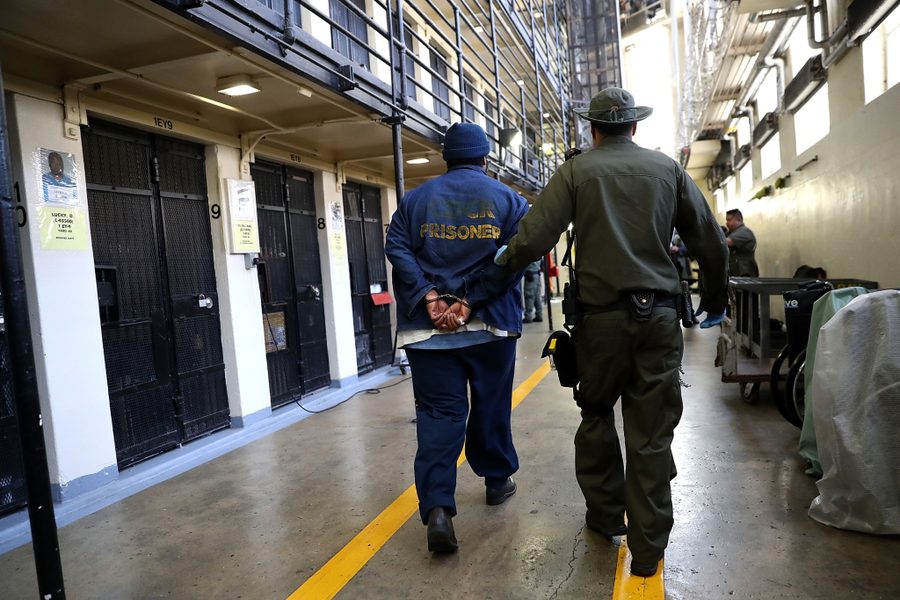Prison Breakdown
Overcrowding has pushed California’s prison system to the brink
Sasha Abramsky, TRUTHOUT

Halfway between Sacramento and San Francisco is Solano Correctional Facility, nestled against a series of rolling hills, on the outskirts of the small city of Vacaville.
From the prison’s guard towers, the view is fairly beautiful: a Mediterranean-type vista of sun-browned grass and squat trees covering green hills, underneath the endlessly deep California sky. But from the windows of the dorms and cellblocks where the inmates live, all they can see is a slender patch of sky.
Inside some of the housing units at Solano, inmates take showers in rooms open to the entire dorm – including guards, both male and female. As naked men soap themselves off, other inmates go about their business in front of them. Hundreds of men share a handful of toilets, as well as the mildew-and-mold-infested open shower area. “There’s maybe 10 operable toilets for 200 guys. You come back from chow in the morning, you stand in line 10-to-20 minutes to use the toilet,” says 47-year-old Michael Donoho, a heavily tattooed repeat offender (drugs, robbery, spousal abuse).
Meanwhile, two one-time gyms – that in better days hosted boxing rings for prisoners – have served as “temporary” dorms since the mid-’90s. Today they house more than 200 inmates apiece. Prisoners are stacked on row after row of triple bunks, with three feet of floor space separating one bunk frame from another. Nobody expects the gyms to return to their intended function anytime soon.
Safety is also an issue. The top bunks in the gyms are well over five feet off the ground and have no railings around them. It is, according to prisoners, fairly common for slumbering third-tier inmates to roll off their narrow metal beds onto the hard floor during the night.
But the sounds of sleeping men falling aren’t the only noises heard after dark. During the long hours of the night, two correctional officers walk the floor and one more stands watch on a raised tier with a gun at the ready. Prisoner representatives from every race sit awake, perched atop their bunks, grimly scanning the walkways in case a rival from another race-based gang decides to launch a small-hours attack.
In the summer, large industrial-scale fans never stop whirring, and when the voices cease in the hours between lights-out at 10 p.m. and the 3 a.m. wake-up for inmate culinary workers, their whir eats its way into the mind. Add in all of the other sounds of a large, security-based institution, and you have the ingredients for mental chaos.
“The whole time I’ve been locked up, I’ve never gotten more than three hours of good, solid sleep,” says a 46-year-old inmate who is serving a six-year sentence on methamphetamine charges. “Alarms going off, guys running around, cops yelling. It’s been a real eye-opening experience.”
When Solano opened in 1984, it was intended to hold 2,610 inmates. Twelve years later, five dormitory buildings were added to the original structure, boosting the prison’s capacity by a thousand inmates. No additional buildings have been added in the past 11 years, yet the sprawling, gray concrete and razor-wire institution now holds 6,111 prisoners.
On paper, Solano has some of the best vocational training programs of any prison in California, with a metal shop that makes snowplow blades for the California Department of Transportation and a lens shop that manufactures almost all spectacle lenses for Medi-Cal – the state’s more expansive version of Medicaid – and Medicare recipients statewide. The facility also routinely places soon-to-be-paroled workers in free-world jobs, such as in lens labs and opticians’ offices, around the state. But on any given day, Solano has thousands of idle inmates because there aren’t enough jobs, education slots and drug addiction treatment spots available for the surplus prisoners.
“We do the best with the resources and staff that we have,” says Public Information Officer Lt. Tim Wamble, as he sits in his tidy second-floor office, its window overlooking one of the guard towers. “There’s no way you can have 6,111 jobs or seats in classrooms. The rest go on waiting lists. Which means they’re hanging out in the yard till something opens up for them.”
— — — — — — — — -California’s experiment in wholesale incarceration is one of the great policy failures of our times. Thirty years ago, California had 12 prisons and fewer than 30,000 prisoners. Today, after a generation of “tough-on-crime” legislation pushed through the legislature and the initiative process – from three-strikes-and-you’re-out to draconian anti-drug and anti-gang legislation – the state has close to 175,000 inmates living in 34 prisons. That means almost one in every 200 California residents is now a prisoner of the state. (And these numbers don’t even include the tens of thousands more prisoners in county jails.) The annual cost to taxpayers is about $10 billion per year, just shy of the amount the state annually puts into its vaunted public university system. If current spending trends continue, California will soon be spending more on prisons than on universities.
Despite the massive funding, scandals have rocked the prison system since the ’90s. At the Corcoran Supermax, guards organized “gladiatorial combats” between rival gang members on the prison yard and would end the fights by shooting the antagonists apart with rubber bullets. Faced with criminal investigations and a media outcry, correctional administrators promised top-to-bottom reform. They failed to deliver.
The state’s youth authority has also been beset by scandals, with videos surfacing that show gangs of officers severely beating juvenile detainees. Large numbers of teens have been held in lockdown conditions that make it impossible for them to attend school. Not too many years ago, close to 10,000 teenagers and young adults under the age of 25 were held in these state-run, youth authority institutions, which were supposed to emphasize education and intensive rehabilitation. In practice, they have become little more than warehouses for young people whom the state has given up on. Today, these institutions hold only 2,500 teenagers and young adults, and current plans envision scaling the number to 1,500. Increasingly, as courts have lost confidence in the state system, juvenile offenders are instead being channeled into juvenile halls run by counties.
What’s more, in the past decade, the state signed deeply unpopular sweetheart contracts with the politically powerful prison officers’ trade union, the California Correctional Peace Officers Association (CCPOA). (The base salary for a long-time CCPOA member is now $73,000, and with overtime, many officers earn more than $100,000 a year.)
Perhaps most damning, by the early years of the century, California had a return-to-prison rate for parolees near 70 percent, which was worse than any other state. By contrast, as of December 2006, Florida’s return-to-prison rate was 53 percent, New York’s was 56 percent and Texas’ was 25 percent, according to data collected by the Center for Evidence-Based Corrections at the University of California at Irvine.
In response, two years ago Gov. Arnold Schwarzenegger brought in new directors to run the system. He also hired a management consultant team, led by Cal State Northridge Professor Alan Glassman, to reform the way the various correctional bureaucracies functioned and to restore public confidence in their workings. At the same time, the state relaunched a multimillion-dollar research arm of the correctional system. Researchers, led by Professor Joan Petersilia from the University of California at Irvine’s School of Social Ecology, had a mandate to study what sorts of programming most positively benefited prisoners.
Such a body had existed in the past and had been seen as being on the cutting edge of American criminology, with its strong emphasis on identifying and promoting rehabilitation strategies tailored to the individual. But it was scrapped during the heyday of tough-on-crime legislation in the ’80s. Symbolically, as a part of this tilt back toward programming, in 2005, the state changed the name of the prison system from the Department of Corrections to the Department of Corrections and Rehabilitation.
But, one by one, the system’s new reformers, led by Youth and Adult Correctional Authority Director Rod Hickman and Corrections and Rehabilitation Director Jeannie Woodford, resigned, disillusioned with the receding possibility for change. And the system’s reputation headed further south, a reality publicly acknowledged by officials from Schwarzenegger to the chair of the state senate public safety committee to prison reform attorneys to Keith Jimenez, president of the CCPOA.
Facing at least the possibility of the entire prison system being placed under court control because of chronic overcrowding, panicked state politicians – urged on by Schwarzenegger – this year approved a $7.3 billion emergency measure, known as AB 900, to expand the system by a mammoth 53,000 beds.
— — — — — — — — -Over three decades, the combination of political demagoguery and public fear has had a toxic effect on California’s criminal justice system. A prime example is the Three Strikes law that passed in 1994 after the high-profile murder of 12-year-old Polly Klass by a violent repeat offender named Richard Allen Davis. Politicians promised the law would ensure that violent predators, rather than petty criminals, would be taken off the streets for at least 25 years. That’s not how it has played out.
Many studies have shown that huge numbers of offenders are convicted of nonviolent, often drug-related third strikes, and that these cases are clogging up both the courts and the prisons. In 2004, the ACLU found that 65 percent of three-strikers had been convicted of nonviolent third offenses, and that 10 times as many Californians have “struck out” for drug possession than for second-degree murder. Close to half of those who have struck out are African American. Yet over several years, California’s elected officials have been unable to agree on how to reform the law.
“There’s no strategy behind the incarceration,” says attorney Sara Norman of the Bay Area-based prisoner-rights group, the Prison Law Office. Her colleague Don Specter goes further. The state, he says, is all-too-quick to incarcerate, but is “unwilling to pay for the humane treatment” of those it locks up for years and even decades at a stretch.
While more and more dollars are being devoted to corrections, the amount of money available per inmate for programming (such as education, drug treatment, vocational training, mental health care and so on) has declined as a percentage of the total cost of incarceration. In June, the state senate subcommittee in charge of overseeing the Department of Corrections and Rehabilitation’s budget reported that a mere 5 percent of the $43,000 California spends on each inmate each year currently goes toward rehabilitation programs.
To understand what has gone wrong, one has to go back more than 30 years and examine a generation’s worth of flawed criminal justice policy-making at both the state and federal levels. It’s what freelance journalist and one-time editor of the Boulder Weekly Joel Dyer once pungently termed a “perpetual prisoner machine.”
— — — — — — — — -The growth in California’s carceral infrastructure is in keeping with changes that kicked in nationally during the ’70s – a few years before California abandoned its liberal criminal justice policies – and that continue to the present day, resulting in a five-fold increase in the number of prisoners nationally. On any given day, about 2.2 million Americans are either in jail or in prison, with approximately two-thirds of these inmates in state and federal prisons. The remaining one-third is in county jails. This has created a $100 billion a year incarceration industry.
The War on Drugs explains much of the explosion, sending huge numbers of men and women, a disproportionate number of them poor blacks and Latinos, into state and federal prisons. The sentences handed out to drug offenders often exceed those served by rapists and other violent offenders.
Meanwhile, deinstitutionalization of the mentally ill, under the banner of “reform,” has left hundreds of thousands of people without adequate access to medications, counseling and effective support networks. Many of them have subsequently spiraled into the criminal justice system. In California, about one in five inmates is seriously mentally ill. The state is struggling to provide comprehensive treatment to these inmates without bankrupting the entire correctional system.
“By the time somebody gets to prison, we’re already a thousand steps behind,” says state Sen. Darrell Steinberg, a Democrat, who has pushed several major reforms in recent years designed to build up community mental health networks and also strengthen mental health care for the state’s tens of thousands of mentally ill prisoners. “The point is, how are we going to keep people out of these prisons? You don’t make up for years of neglect in one or two or three years.”
Movement away from indeterminate sentencing – a process originally supported by both the left and right – has generally resulted in more people serving longer sentences. So, too, did curtailment of parole and the passage of “truth in sentencing” laws that made prisoners serve almost all of their sentences before being eligible to go up before the parole board – both reforms popular with the newly powerful “victims rights” movement in the ’90s.
Yet California’s prison system is peculiarly dysfunctional. A half century ago, under Gov. Edmund “Pat” Brown, the state was known for having one of the most progressive prison systems in the country, one that emphasized rehabilitation, drug treatment, education and alternatives to incarceration. Some of its prisons even boasted world-class libraries behind their imposing walls. That trend held through Ronald Reagan’s years in Sacramento (1966−1974), and stayed good as recently as the gubernatorial tenure of Pat Brown’s son, Jerry, in the late ’70s. But today, after the disastrously “tough” consecutive gubernatorial tenures of George Deukmejian, Pete Wilson and Gray Davis from 1983 to 2003, the system is a byword for failure.
In January, the Little Hoover Commission, a major Sacramento-based think tank, issued a report that declared the system to be “in a tailspin that threatens public safety and raises the risk of fiscal disaster.” Almost all of the system’s correctional institutions are operating way over capacity, with some, like Solano, at near double capacity for about a decade now, according to the report.
Because Solano is a medium security institution, housing level II and level III inmates, prison administrators have the option of simply cramming more and more bodies into open spaces, a “luxury” not available to wardens in charge of higher security facilities. For example, at high security sites, such as the supermaxes of Pelican Bay, located in Crescent City, in the far north of the state, and the Central Valley’s Corcoran prison, prisoners must be locked up in individual cells and allowed out for, at most, one hour per day.
California’s solution? Build still more prison beds – and hope these beds end up solving the existing overcrowding problem, rather than simply becoming an excuse to incarcerate evermore offenders.
At the heart of AB 900, the bill Schwarzenegger signed into law this year to tackle the overcrowding crisis, is a $7.3 billion bond act that will be used to build housing for more than 50,000 new beds. In a departure from recent spending priorities, many thousands of these beds will be specifically reserved for rehabilitation units, drug treatment centers and mental health sites within correctional settings. The legislation also seeks emergency short-term responses to address overcrowding, including allowing the state to ship 8,000 prisoners to privately run facilities in Arizona and Mississippi.
Some critics have lambasted the legislation as paving the way for the biggest single prison-building spree in U.S. history, but its supporters argue it represents a new dawn for the troubled system. Bill Sessa, a spokesman for the California Department of Corrections and Rehabilitation, says that after decades of inertia, the department finally has a plan, “and we should be given time to make the plan work.” Defending the combination of building plans and rehabilitation ambitions, he explains that “before you can have rehabilitation programs, you’ve got to have places for them.”
The truth lies somewhere in between these two arguments. Given the number of people being sentenced to prison in California, more beds are certainly needed. The question is: Might it not have been a wiser strategy, albeit a more politically risky one, to create a Sentencing Commission? In the wake of the post-2001 fiscal crises experienced at the state level, several states have used such commissions to reexamine many of the mandatory sentencing laws put in place since the ’70s, in order to lower the numbers coming into prison and to shrink the prisoner population. AB 900 sidesteps this more in-depth, systemic, approach to criminal justice reform, instead focusing on delivering more services within prison settings.
And here’s the rub: Even assuming AB 900 works in the long run, it’s increasingly likely that the courts won’t be willing to wait that long. In June, two federal judges for the eastern district of California, Thelton Henderson and Lawrence Karlton, held hearings in a packed, wood-paneled, 16th floor courtroom in Sacramento’s Federal Building. They discussed how prison overcrowding was making it impossible to deliver constitutionally acceptable levels of medical and mental health care to prisoners. Over the past several years, the judges had presided over two separate cases, one on the provision of mental health services inside prisons and another looking at the general quality of health care services behind bars. With plaintiffs in both cases now arguing that chronic overcrowding is making it impossible for court-ordered improvements to be implemented, Henderson and Karlton decided to pool their resources and hold one set of hearings on the issue.
“There are no rehabilitative programs,” Karlton noted testily. “Part of the problem is this is a fantasy. They barely have the ability to house people. Where are you going to find the space to meaningfully rehabilitate people?”
Don Specter, from the Prison Law Office, argued the situation is now so dire that only a court-imposed population cap on the prison system can nudge the state toward effective changes. He calls overcrowding “a crisis of constitutional dimensions that is dangerous for prisoners, unsafe for staff and a threat to the public.” Specter and his colleagues urged the two judges to form a three-judge panel that would hear arguments and decide whether to force the state to rollback its prison population. To the amazement of many observers, they received an amicus brief from the prison workers’ trade union, CCPOA.
The prison system, the CCPOA now argues, is in near-terminal crisis, with wardens unable to fill vacancies for several thousand guards’ jobs, despite the high salaries offered correctional officers. The association asserts that the Department of Corrections and Rehabilitation is massively failing in its newly rediscovered mission to rehabilitate incarcerated offenders. It is, according to the union, a tinderbox ready to explode, with union members at risk of being attacked by inmates because of poor prison conditions.
While some of the CCPOA rhetoric is gamesmanship – the union responding to political intransigence on the prison issue and to its stunning loss of ground in contract negotiations in the years since Gray Davis lost office – not all its criticisms are just for strategic effect.
“AB 900 was a farce, a scam perpetuated against California’s people,” says union spokesperson Ryan Sherman, over lunch at Chops, one of Sacramento’s favorite hangouts for lobbyists. “It was designed to hoodwink the federal government that they were finally taking action to end the crisis. It’s not real. It’s not reform. It’s prison construction.”
According to Sherman, corrections spending in California has doubled in the past four years and corrections itself hasn’t gotten better. “We shouldn’t be spending so much locking up more and more people. Other things impact our members, not just in prison but in the community. Better schools. Better roads. A lot of things are important,” he says.
In the end, Henderson and Karlton agreed to create a three-judge panel that will decide whether to impose a population cap on the state’s prison system. It will start hearing arguments sometime this fall. And the panel may begin imposing a population cap as early as 2008.
Absent rapid and wholesale release of inmates – which even proponents accept is hardly an ideal solution to California’s woes – ongoing overcrowding means that many prisoners will spend years in settings like Solano. And, in a throwback to pre-modern prison conditions, all sorts of criminals are mixed together in these latter-day communal dungeons. “You might have a guy in here doing 16 months for a DUI and a guy doing 10 years for robbery,” Lt. Wamble acknowledges.
Not surprisingly, in addition to being petri dishes of criminality, the gym dorms in Solano and elsewhere are breeding grounds for disease. In the past few years, chicken pox epidemics have broken out, one gym had to be locked down to contain a spreading tuberculosis contagion, gastroenteritis has run rampant, inmates regularly report devastating flu outbreaks and staph infection is commonplace.
“I got sick, like a flu, when I first got in here,” recalls 22-year-old Ramon Wilson, who is serving five years on a drug conviction. “I couldn’t get out of bed I was so weak. Nauseated. Couldn’t eat.” He continues, “I’ve seen spider bites. Mice. Rats running around. Mice will get inside the lockers and eat the food. There’s people on hot meds – psych meds – who can flip out any second. The C.O.s [corrections officers], some give us respect, others play games like we’re little children.”
The correctional system’s ability to provide constitutionally mandated levels of health care has been successfully challenged in a series of lawsuits. And the mental health system is in such shambles that it has been removed from state control and is now being run by a federal special master.
— — — — — — — — -California’s story is in many ways akin to what took place in almost every state in America since the ’80s. A nationwide lunge to the right, politically and culturally, has resulted in a dismantling of rehabilitation programs, a vast growth in the penal infrastructure and an increased emphasis on locking more people up for ever-more-petty offenses; putting in place ever-harsher conditions, such as secure housing units and supermax prisons; and an unprecedented transferring of the mentally ill, the drug addicted and the undereducated poor into the criminal justice system.
But while these trends are national in scope, California’s size and its tough-on-crime mentality have produced a prison system that is unique both in its scale and, increasingly, in its sheer dysfunction and utter failure to rehabilitate.
“California basically started warehousing people in the early ’80s and that’s when things started going to hell,” Dale Richter of the prison-reform group Friends Committee on Legislation in California argues. “California’s correctional system hasn’t had a defined mission for quite some years.”
Today, California stands on the threshold of a new era. Unless the state’s residents send strong signals to their elected officials that enough’s enough when it comes to prison-building, it will only be a matter of time before more state dollars go into locking up its citizens than providing its young people with a public university education.
In many ways, California remains a place of dreams, the pot of gold at the end of the American rainbow. But its criminal justice policies have, at the very least, put a dent in the optimism. California’s gold rush to mass incarceration reflects priorities gone awry to a spectacular degree. It has taken three decades to get this far off track. Let’s hope it doesn’t take that long to put the state’s criminal justice system back on a fairer, saner footing.








